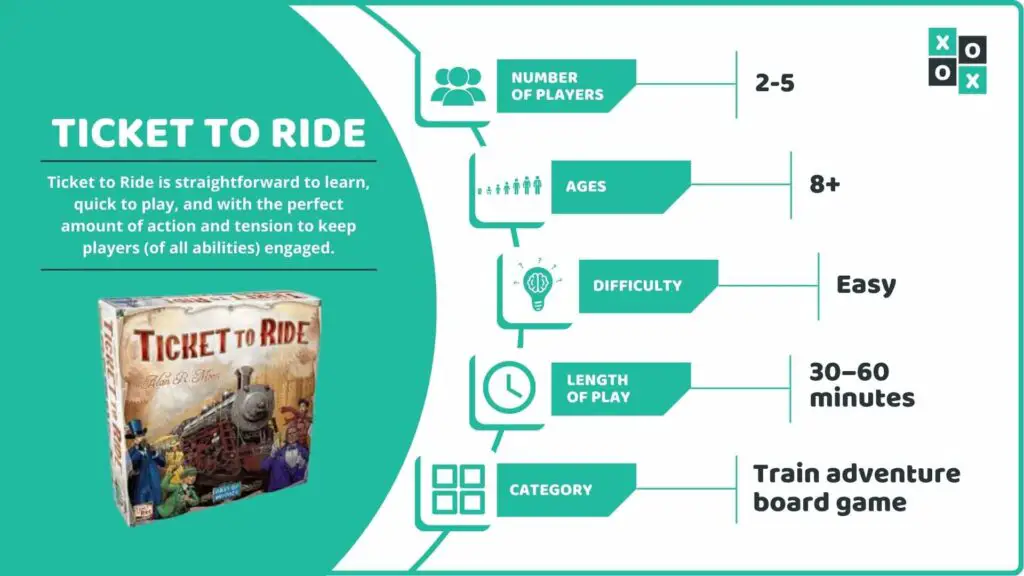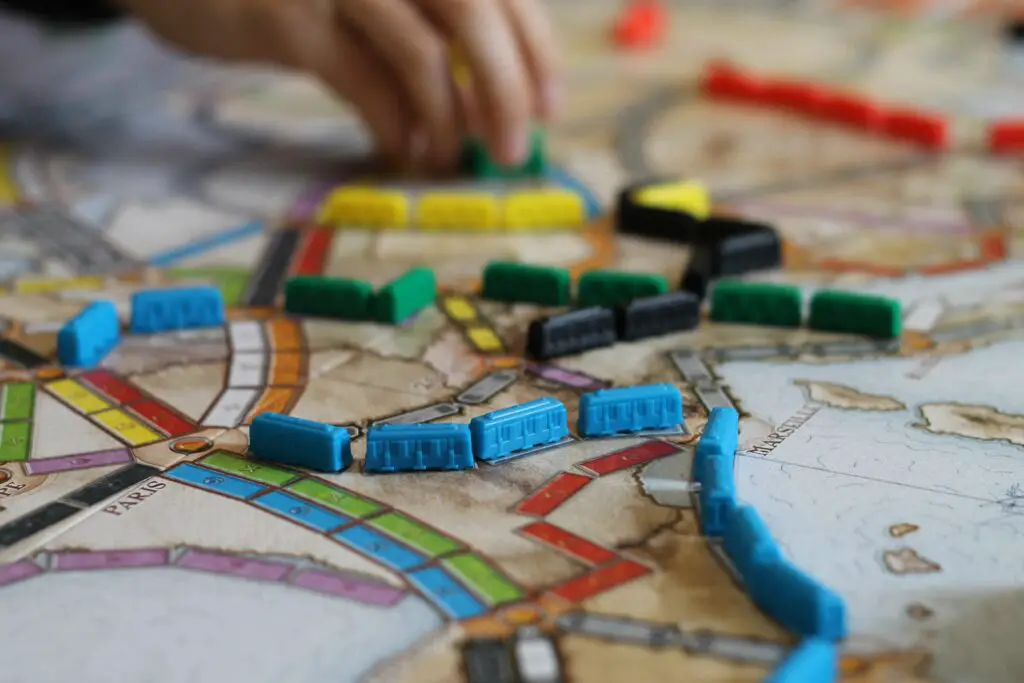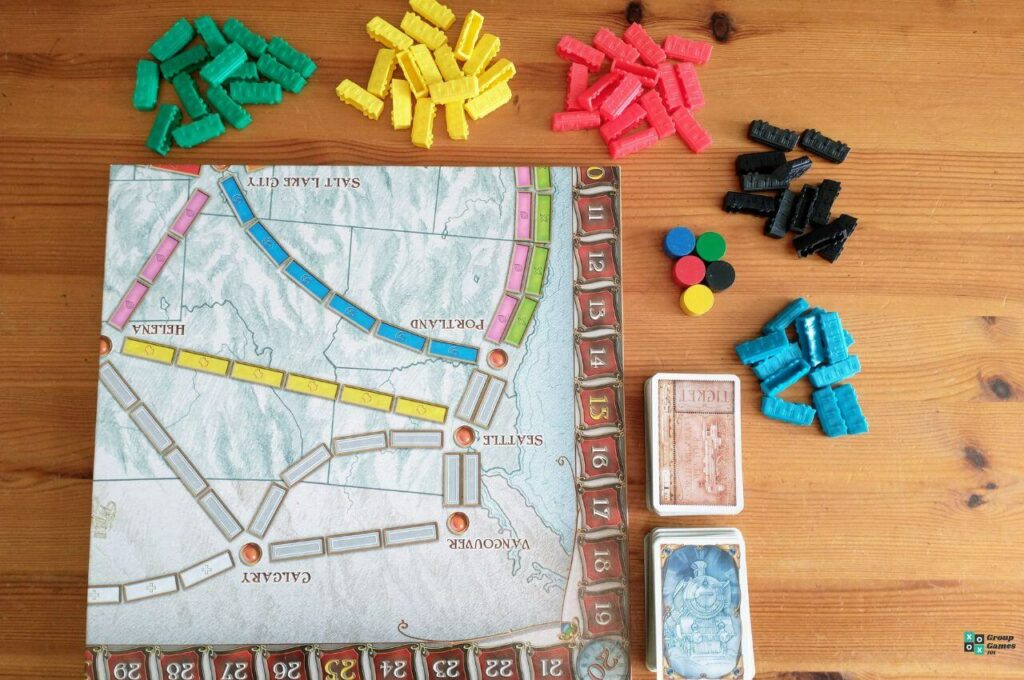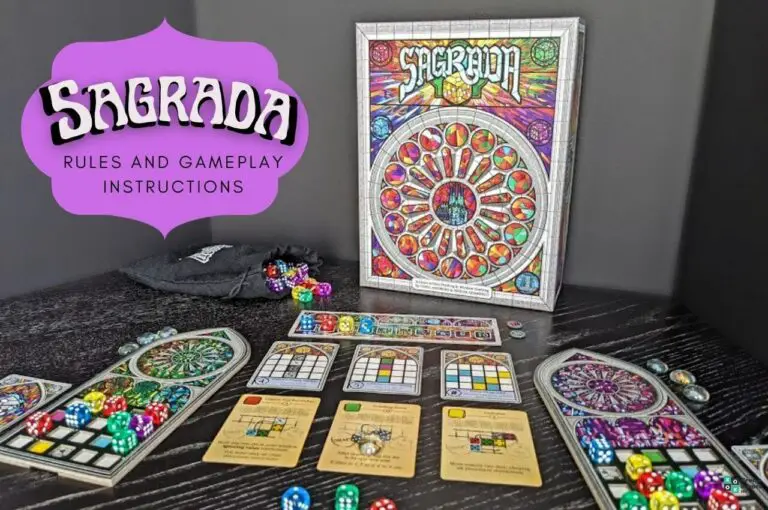If you are looking for a family-friendly, easy-to-learn, and award-winning board game, then learn the Ticket to Ride board game rules to see if this could be the perfect game for you.
Ticket to Ride is straightforward to learn, quick to play, and with the perfect amount of action and tension to keep players (of all abilities) engaged. With elegantly simple gameplay, it takes around 15 minutes to learn the game and between 30 – 60 minutes to play it.
We rate Ticket to Ride highly as an indoor group game for kids to play and love the Geographical and Historical learning that can come with the game, making it educational and fun.
If you love board games, trains, competition, and travel, then you’ll love this game!
Read on to find out how to play Ticket to Ride.
What is Ticket to Ride?

It is a cross-country train adventure game, with various editions available to include different countries, eras, and age levels. Players collect different types of train cards that let them take ownership of railway routes to connect various cities along the way.
The player with the most cities, or longest route, wins the game.
Ticket to Ride has previously been nominated for and won a series of awards, including Origins Best Board Game 2005 and the International Board Game Award in the multiplayer category.
Number of Players: 2 to 5 players.
Ages: Recommended 8 Years and Over
Difficulty: Easy
Length of Play: 30 – 60 Minutes
Similar To: Ticket to Ride First Journey, Trans America, Pan Am, Railroad Ink, Carcassonne.
Main Objective: Claim routes, complete a continuous path of routes between 2 cities listed on your Destination Tickets, complete the longest continuous route.
Why We Love it: The big format board game features high-quality illustrations that are interesting to look at while waiting for your turn, thus, preventing boredom in younger children.
The game is easy to learn, great fun to play and can provoke engaging, educational debates with kids. The balance of action, adventure, strategy, and luck is perfect. We can’t fault this game.

A Brief History of Ticket to Ride
Ticket to Ride was published by Days of Wonder in 2004. Very soon after, the game began to receive numerous nominations and awards, being received very well across the world. To date, it’s one of its most popular board games.
The original version is a board depicting a railway map of the USA and Southern Canada, but quickly Days of Wonder produced different versions, including other countries, cities, time eras, and a simpler version for younger kids; First Journey, for ages 6+.
The game nearly didn’t make it after its creator; Alan R Moon grew tired of designing table-top board games to receive no interest. After a childhood spent enjoying playing games of Risk with his family, he wanted to recreate this for others.
Alan R Moon came up with the concept of Ticket to Ride during a morning walk. As a last-ditch attempt to make it in the world of board games, he sent the design to 3 different publishers, only 1 replied.
Thankfully, the interested publishers were highly interested. A year after their initial meeting with Alan R Moon, the Ticket to Ride game we know and love today was born.
What You’ll Need to Play Ticket to Ride
Everything you need to play Ticket to Ride is in the box.
The original box contains:
- 1 Board Map of Train Routes
- 225 Colored Train Cars
- 144 Destination cards
- 5 Scoring Markers

How to Play Ticket to Ride
The game’s objective is to get the longest continuous route on the board, the premise is simple, but other players can block your way. There is little you can do to control the movement of other players, but strategic planning can help.
The winner is the player with the most points, and you can gain points in 3 ways; every time you place trains on the board and connect 2 cities, by completing Destination Cards or having the longest continuous route at the end.
You will lose points for any uncompleted Destination Cards at the end of the game.

Related: Ticket to Ride Europe rules
Setting up the Game
Setting up the game is really simple and goes as follows:
#1 Layout the board, and each player chooses a color
#2 Place each players point tracking token in the corner next to the 1
#3 Shuffle the train cards and deal 4 to each player
#4 Place the deck on the table and turn over the top 5 cards (face up) on the table
#5 Shuffle the destination cards before dealing 3 to every player – players can discard 1 if they want to
Any discarded destination cards must be placed at the bottom of the pile
Destination cards must remain hidden from other players
#6Giveeach player 20 trains each
#7 The player with the most travel experience goes first
Ticket to Ride Rules
The gameplay proceeds around the table after the first player has taken their turn. Each player gets one turn and must perform one of the following actions:
#1Draw 2 Train Car Cards: You can draw 2 Train Car cards and take any 1 of the face-up cards or a card from the deck (known as a blind draw).
#2 Claim a Route: You can claim a route by playing the same color Train Car cards as the length of the same colored route. To claim it, place one of the colored trains on each space, then record the score via the Score Marker.
#3 Draw Destination Tickets: Draw 3 destination tickets from the top of the deck, you can discard 2 or 3, or keep them all, but you must keep at least 1.
Players can have any number of cards in their hand, higher than 1.
Gameplay
As explained above, each player has 3 options for their turn. Here’s a more in-depth look at what each choice can bring and how to play them.
Draw Train Cards
You’re able to take 2 cards from the top of the deck or from the 5 face-up cards on the table. If taking a card from the face-up selection, you need to replace it immediately with a card out of the deck.
You can then choose another card from the face-up selection or from the top of the deck.
This is different for Locomotive Cards.
If you draw a locomotive card from the face-up cards, you can only take this 1 card. If you draw a locomotive card from the top of the face-down deck, then you can take a second card.
If there are 3 locomotive cards in the face-up selection, then you must discard them all, put them under the deck and draw 5 new cards from the top.
There are 8 different types of Train Cards.
On the board, there are different colored routes across it, connecting the various cities. These routes match with the train cards in the deck – Purple, White, Blue, Green, Black, Yellow, Orange, and Red.
The locomotive cards are multi-colored and wild cards, meaning you can use them as any color you need to complete a route.
Claim a Route
To claim a route, you can play a set of train car cards that match your desired route’s color and length. To do this, you must place your colored train on the route and move your marker to keep track of your score on the outside of the board.
To claim a route, you need to have the correct number and color of train cards to match the route you want.
On the board, there are some gray routes, which don’t match any color. You can claim these routes by using any color train card as long as you have the correct number for the route.
For example, you can claim a gray route that is 4 trains long, with 4 cards of the same color (all purple, all blue, etc.)
When you’ve used your cards to claim a route, they then go into the discard pile.
For cities that are connected by a double route, a single player cannot claim both routes.

Draw Destination Cards
Destination cards are to be kept secret from other players, and there is no limit to how many you can have. But, it is important to remember that points will be deducted for any destination cards left in your hand that have not been completed – so don’t be greedy!
When taking extra destination cards, you should consider where you are in the game. For example, if a player is down to their last few trains, the game is likely about to end, and so it may be unwise to leave yourself with point-deductible cards at the end.
Game End
When a player is down to 1 or 2 trains at the end of their last go, then every player gets a final turn. The game then ends, and it’s time to calculate the scores to see who has won.
In turn, players need to reveal their destination cards, then add or subtract the points – depending on whether or not that route has been completed.
Next, see which player has the longest continuous route on the board. This is worth 10 points. If more than 1 player has the same path route length, then they too receive 10 points.
The player who has the most points wins the game.
If 2 players have the same amount of points (which is unlikely), then the player who has completed the most destination tickets wins.
Frequently Asked Questions
Can You Run Out of Trains in Ticket to Ride?
Each player begins with 20 trains. When a player’s down to their last couple of trains, the game comes to an end, so it isn’t possible to run out of trains.
Can You Play Ticket to Ride Strategically?
Ticket to Ride is more of a game of chance, but that doesn’t mean you shouldn’t try to up your chances. The main thing to remember if trying any strategy in this game is that you must be able to adapt as the game progresses.
It’s important to be able to alter your strategy based on what you’re dealt in the game.
Is There an Online Version of Ticket to Ride?
The thought behind the game was to get people away from online gaming and back to traditional table-top gameplay. However, there is an online version available to download and play solo or with players worldwide.
A new online game of Ticket to Ride is started every 4 seconds, so this is pretty popular.
Alternative Games to Ticket to Ride
If you’re looking for a more straightforward board game, then CandyLand is a great introductory game for preschoolers to learn patience. The objective of this board game is to be the first player to reach Candy Land; there are innocent obstacles along the way that keep the game exciting.
Wingspan is much more in-depth than Ticket to Ride, although similar in the way that each player has a limited number of actions to take per turn, with the objective being to complete a venture (in Wingspan, it’s an aviary, in Ticket to Ride it’s a train route).
If you fancy a game of fantasy and mystery, then Dragonwood could be a good board game to consider. Dragonwood is also recommended for ages 8 and upwards and takes the same amount of time to play. Although, the gameplay is a little more complicated than Ticket to Ride.








